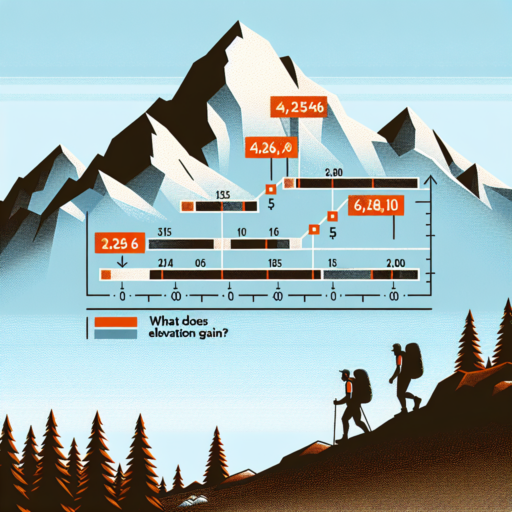What is meant by elevation gain?
Elevation gain refers to the total amount of vertical ascent (or climb) over the course of a hike, run, bike ride, or any other form of physical activity that involves movement over varying terrains. Unlike total elevation change, which accounts for both ascents and descents, elevation gain solely focuses on the accumulation of all upward travel, providing a measure of the total altitude difference climbed during an activity.
Understanding elevation gain is crucial for outdoor enthusiasts and athletes as it offers significant insights into the physical demands of a route. It is a key metric for planning, allowing individuals to assess the difficulty and necessary preparation for tackling terrains. Elevation gain is not only about the magnitude of an ascent but also about the rate at which the elevation changes over distance, which can significantly impact the overall challenge of the activity.
Technology and mobile apps have made tracking elevation gain more accessible and accurate, enabling adventurers and athletes to analyze their performance and tailor their training accordingly. Whether measured via GPS devices or traditional mapping techniques, knowing the elevation gain of a route helps in setting realistic goals and expectations, preventing overexertion and enhancing the outdoor experience.
No se han encontrado productos.
Is 1000 ft elevation gain a lot?
Understanding whether a 1000 ft elevation gain is considered significant depends on several factors, including the individual’s fitness level, hiking experience, and the context of the gain itself. For seasoned hikers and outdoor enthusiasts, a 1000 ft elevation gain might be seen as a moderate challenge, easily accomplished within a couple of hours. However, for beginners or those unaccustomed to physical activity, this same elevation gain can appear daunting and may require significant effort and preparation.
Elevation gain is a critical measure used by hikers, runners, and cyclists to evaluate the difficulty of their outdoor adventures. It refers to the total amount of upward ascent over the course of a trail or route. A 1000 ft elevation gain spread over a mile is much steeper and potentially more challenging than the same gain over a distance of three or five miles. Thus, the distance over which the elevation gain occurs plays an essential role in determining the relative difficulty of a trek or ride.
Another factor to consider is the environmental conditions, such as weather, trail surface, and altitude. A 1000 ft gain in a high-altitude area can feel significantly harder on the body due to the thinner air and lower levels of oxygen. Similarly, a steep, rocky trail will demand more from a hiker’s muscles and balance than a gradual, well-maintained path. Therefore, assessing the difficulty of a 1000 ft elevation gain requires consideration of not just the number itself, but the context in which it occurs.
Why is elevation gain important?
Elevation gain, or the cumulative vertical distance one climbs, is a crucial aspect for several reasons. Primarily, it serves as a key indicator of the physical challenge and exertion level of a hike, run, or bike ride. Understanding the elevation gain of a route helps athletes and outdoor enthusiasts prepare both mentally and physically for the challenge ahead.
Moreover, elevation gain directly impacts calorie burn. Activities that involve significant elevation gains require more energy, leading to a higher calorie burn compared to flat terrain exercises. For individuals focused on weight loss or improving cardiovascular health, selecting routes with considerable elevation gain can be particularly beneficial.
Furthermore, elevation gain contributes to skill development. For hikers, runners, and cyclists, regularly tackling routes with substantial elevation gains enhances endurance, strength, and technical skills. As one becomes more accustomed to these conditions, their overall performance and capability in navigating diverse terrains improve markedly.
What does elevation gain mean on Strava?
The term elevation gain on Strava refers to the total vertical distance a user has ascended during their activity. This metric is crucial for cyclists, runners, and hikers who use Strava to track their performances, as it gives a clear idea of the intensity and challenge of the terrain they’ve traversed. Not simply a measure of distance, elevation gain offers a comprehensive view of how much uphill work was involved in a session, providing an additional layer to activity analysis beyond just pace and total distance.
Elevation gain is calculated by Strava using GPS data collected during your activity. This data is analyzed to identify all the upward stretches along your route, and their vertical distances are summed up to represent the total elevation gained. The accuracy of this metric can be influenced by the quality of the GPS signal and the device’s capability to accurately measure changes in altitude, making some devices more reliable than others in providing a precise elevation gain figure.
Understanding your activity’s elevation gain is pivotal for tracking progress and setting goals. For athletes preparing for events with significant uphill components, monitoring elevation gain can help tailor training to specific demands. Additionally, it’s a valuable tool for gauging the difficulty of different routes, enabling users to compare their performance over time and against the efforts of others in the Strava community. By paying attention to this metric, Strava users can focus on improving their strength and endurance in uphill scenarios, which is often where challenging races and rides are won and lost.



